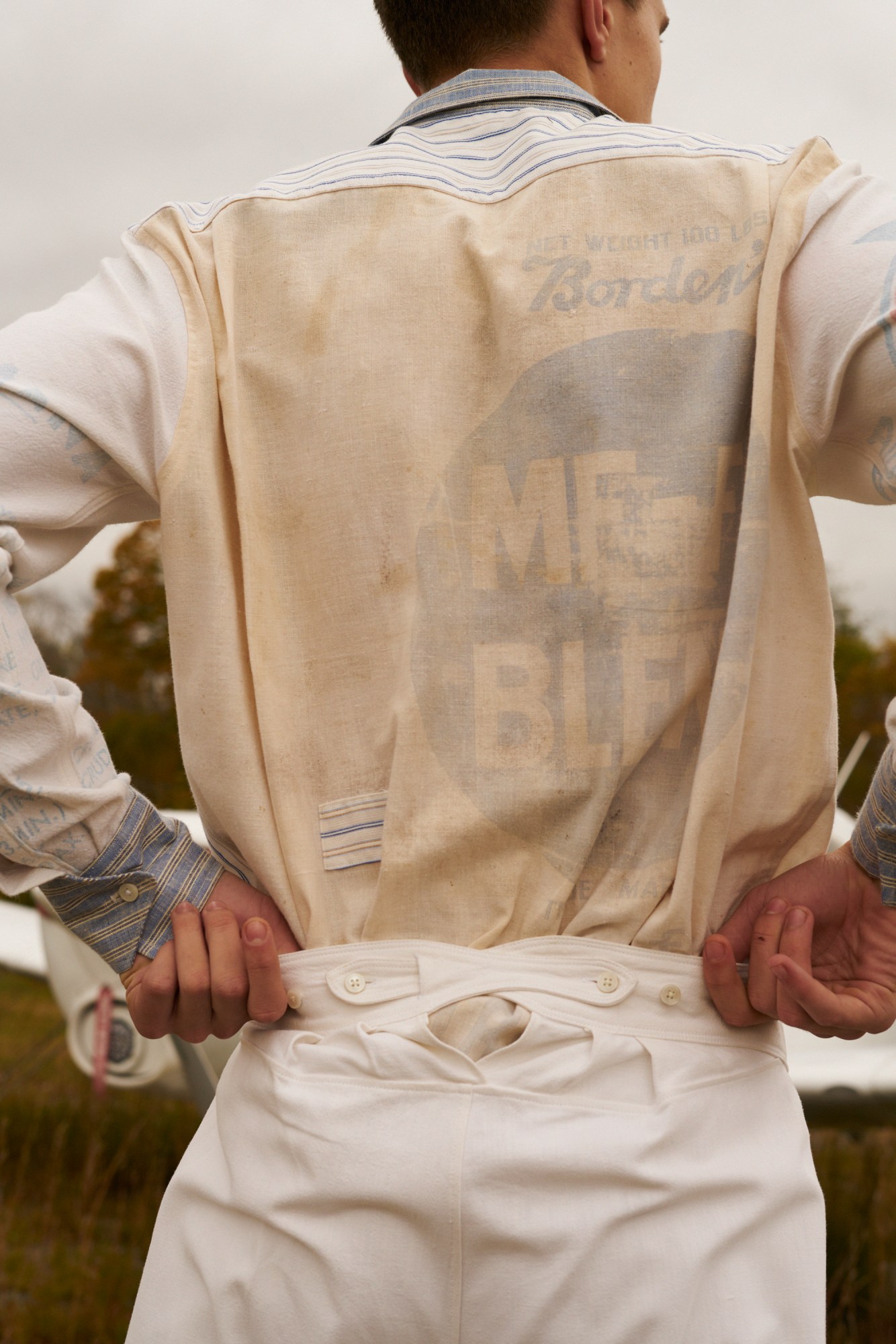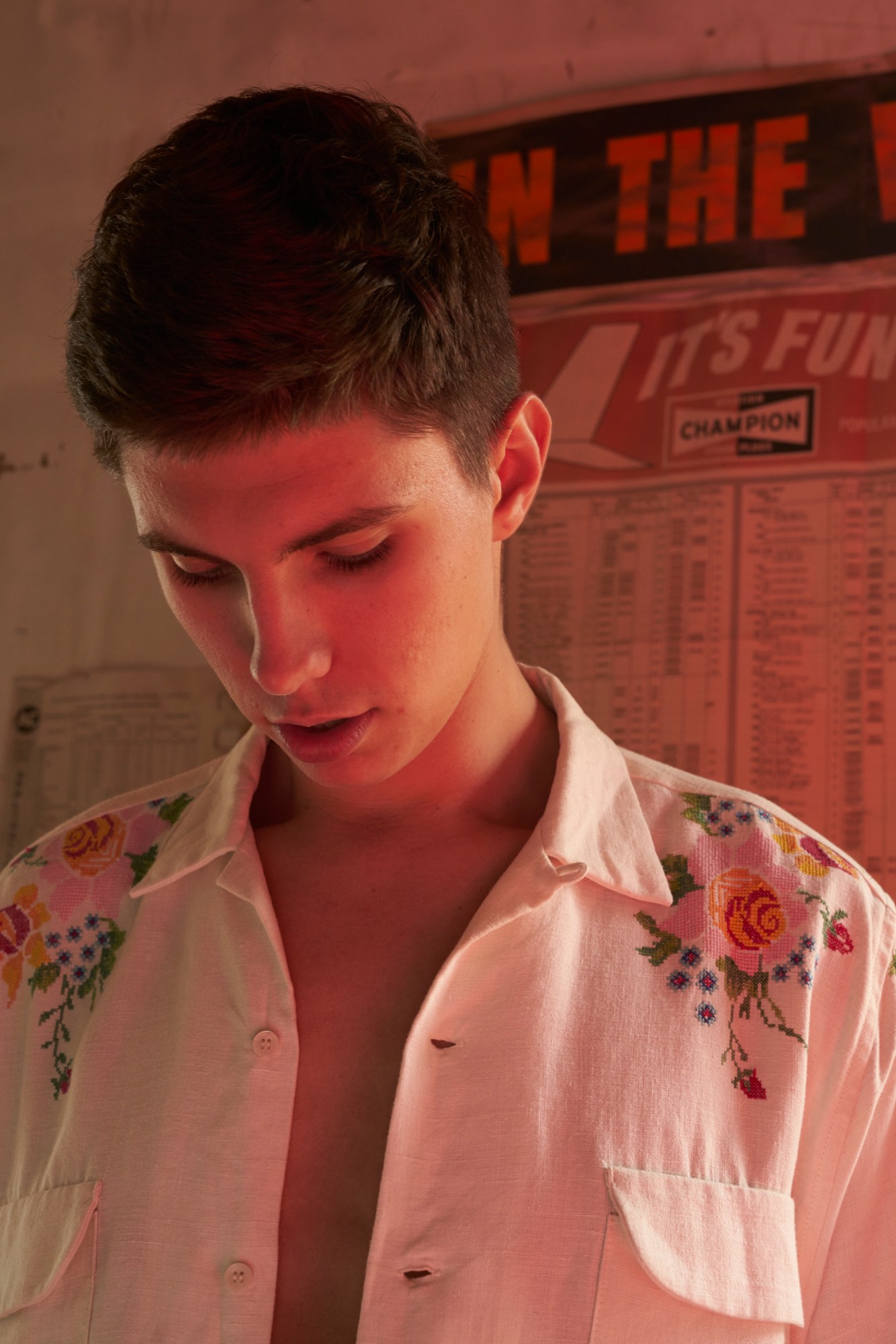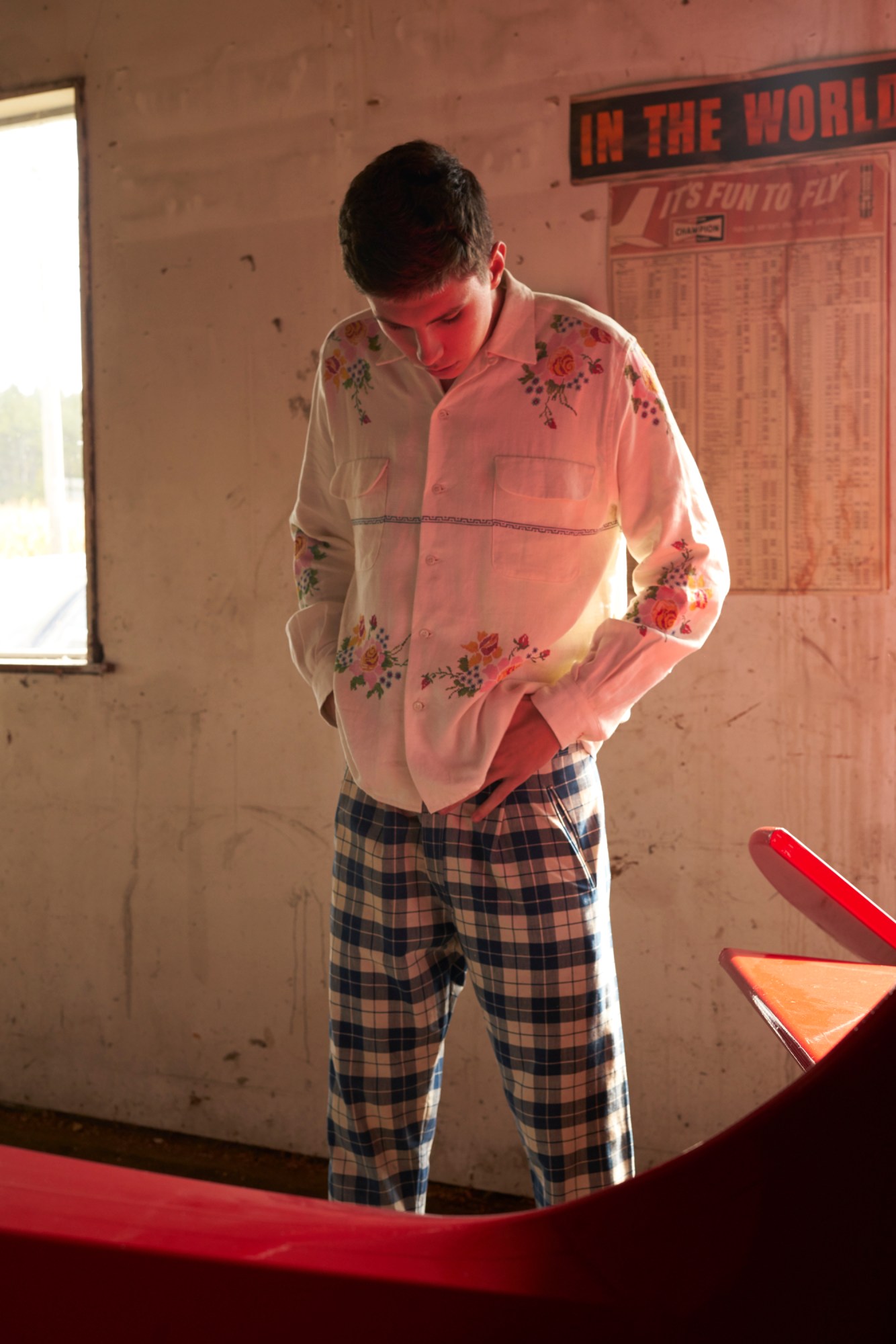When I arrive at Emily Adams Bode’s apartment-cum-studio overlooking Stanton St., late-afternoon light fills the space. The golden glow first touches the designer’s bookshelf (a small library of fabric-dating titles), then stretches across racks of the workwear jackets, linen shirts, and quilted trousers that form her eponymous menswear line.
Bode has lived and worked on the Lower East Side for nearly a decade. (In which time, she earned a dual degree in Menswear at Parsons and Philosophy at Eugene Lang, and interned with Ralph Lauren and Marc Jacobs). Yet she’s been accumulating the textiles in this room — Victorian-era quilts, 1920s linens, embroidered kimono style-pieces — throughout her life. Many are three or four times her age, 28. Recontextualizing traditionally domestic materials as wearable garments, Bode creates one-of-a-kind heirlooms for a new generation to treasure.
Each of Bode’s pieces is made in New York, with local tailors who cut each garment by hand. Fabrics, however, are globally sourced. Quilts tend to come from Massachusetts, Pennsylvania, and Ohio. Linens and wools, from France, England, and Italy. She’s made work jackets with strip-woven cotton from Mali, and trousers using gorgeous indigos from Côte d’Ivoire. Bode buys along her own travels, stopping at any trade shows and antiques fairs she comes across. Many of the textiles come to her through a close-knit network of vintage dealers. This exchange of tradition, technique, and trust is crucial.

“A huge part of my brand is archiving,” Bode explains. And that goes beyond the restoration of her materials. “Creating a space to hold stories is so important. Oral histories, sound tidbits, maps. Taking the time to record: ‘This quilt was made from this. It was found at this place. This color was popular at the time it was created, because of these reasons.’ So much is being lost and forgotten.”
The designer herself is a reliquary. (Point to any garment or bulk of fabric on her shelf and she’ll tell you its historical context). As such, she sees her pieces as individual items to cherish, and produces them year-round. Seasonal collections are presented at New York Fashion Week: Men’s, and are generally inspired by a personal narrative relating to a home, or domestic space.
Last season, Bode visited her 83-year-old great-aunt in the south of France, near Nice. She stayed in the attic, full of linens and memories of when her uncle lived there in his teens. The season before (her first on the NYFW schedule) was inspired by that late-afternoon light — not in her New York studio, but on Cape Cod, where Bode’s family has summered for decades. Models languished in the golden-hour glow, reading the paper or watering plants in a room imagined after a long-lost house. “I trust people that have a relationship with Cape Cod, I don’t know why,” she laughs. (I proudly tell her I grew up there).
On Monday morning, Bode will open New York Fashion Week: Men’s with Dear Homer, a collegiate collection inspired by a unique Cape character. Below, she tells us about it.

Your first collection, based on your mom’s Cape house, was really beautiful. Tell me about the story this season.
The Cape is my second home. My mom’s family sold their house in East Dennis when her dad died. But she kept the tradition going with her sisters by renting each summer. She continued to rent with my dad, and we went back every summer. Now, I stay in Truro, and try to go for at least a week or two whenever I can. My inspiration this season is about a friend I met in Wellfleet. His name is Homer.
He went to Harvard for Botany, was a teacher at Bard, and now — he’s in his 70s — resells antique quilts. Every summer, I buy from him and he gives me little tidbits of information about the quilts and his life. He’s so inspiring to me as a person. His mind is full of all these histories and intricacies of textiles and botany. It’s really nice to just converse with him. I wanted to reference his stories, and expand them into a whole collection about a botanist’s childhood.
The collection is loosely based on Homer, but more about what I can imagine what his childhood would be like. He’s told me about his mother and his sister — who were both quilters and sewers — and about when missionaries would come to his town. They’d dress up and do extravagant plays for him, then he’d resell all their little knick-knacks. He still has a mischievous little smirk, so I can only imagine what he got up to.
He’s also taught me so much about color theory. Throughout the collection, I implemented shades of green that were popular in the 1930s, post-Great Depression. It’s about juxtaposing playful childhood elements — like beading and hand-drawing — with the more tactile facets of botany, and with a collegiate Ivy League sensibility. For the [NYFW: Men’s] presentation, I partnered with Green River Project LLC, who built a greenhouse and furniture for the show.

What motivated you to study philosophy and design?
I think everybody should have some sort of training in philosophy, even if it’s a class in high school. It’s valuable to explore ways of thinking. How do you go about questioning why you think certain things, or why you act certain ways? Fashion is something I knew I was going to do; philosophy is something that is challenging to me and that I wanted to study. It’s not that I see myself ever being ‘done’ with fashion, but I do see the philosophy aspect of my life as something that’s ongoing.

Do you feel it’s impacted the way you think about clothing?
Generally, I’ve always had a pragmatic approach to design. When I was a student and wanted to go out at night, I’d make myself something to wear. Everyone else made really beautiful, avant-garde stuff for their thesis collections. But it made more sense to me to do workwear-inspired shapes. If I were a teacher, I would encourage those sensibilities. College is a time to express yourself, but I think you should be able to wear at least part of your collection, even if it’s avant-garde. When I look at students’ collections, I often see clothes that are projects. Whereas I was just making clothes. People sometimes ask why I’m not doing womenswear now. A big part of the reason is that I like the challenge of separating myself from my customer. I’m able to reflect on my customer, and understand him. Would my guy friends wear this? Would it look good on them?

What does the future look like for you?
It’s really about changing the culture of the fashion industry in the way we relate to our personal histories. People aren’t putting these quilts on their beds anymore. We tirelessly mend the quilts to preserve them, and we don’t dye anything that’s historical. Someone took the time to position a certain color in a certain place. You have to archive that. With the help of my mentors, librarians, and grant programs, we’re beginning to framework out an archive. There are some databases online, but a lot of the information in the fabric dating books I use isn’t available. I try to keep things small and limited, because I don’t want to sell at massive retailers with these kinds of products. When I was making clothes at other companies, the amount of waste was just so sad. People shouldn’t design this way. The idea of making clothing without having an idea of where your materials are coming from, or where your wash houses are, is a shame. No matter what you do, it should be sustainable.




